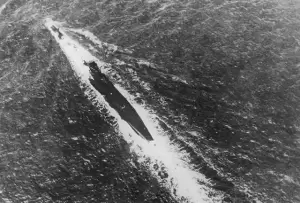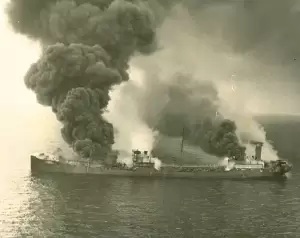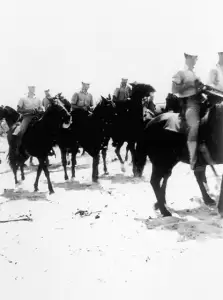The Enemy Presence: German U-Boats

German submarines, or U-boats, aimed their torpedoes at tankers and freighters along the eastern coast of the United States to disrupt delivery of supplies as well as to lower morale; sinking ships burned within sight of American civilians. The ships were not hard to find. Northbound ships followed the Gulf Stream, the world’s largest warm water current, and southbound ones hugged the coast even closer, forming a concentration of targets unlike anywhere else.
The Germans sank 24 ships in Florida waters during the war, eight of them off Palm Beach County between February and May of 1942. Half of those went down near Jupiter Inlet. The greatest loss of life, however, was on October 20, 1943, with no help from the Germans. Two U.S. tankers collided off Jupiter while traveling, as ordered, without lights. Although the Gulf Bell was empty, the Gulfland’s load of gasoline caused an explosion that killed 88 of the two ships’ 116 men. The resulting flames lit up the sky for seven weeks, holding authorities at a helpless distance. The tide turned against Germany when Allied ships started to travel in convoys with armed naval escorts.

In February 1942, a German U-boat torpedoed the Republic, an empty tanker, off Hobe Sound in Martin County. The next day a local man salvaged one of its lifeboats and was barely able to tow it through Jupiter Inlet, which was nearly closed. This would be the last boat to pass through the inlet until 1947. It was banked with sand between the jetties to allow the Coast Guard’s beach watchers to patrol the coast on horseback.
Reports of Germans coming ashore from submarines off Palm Beach County have been controversial since World War II ended. It is likely that a few of the enemy made it to shore, and most were promptly and quietly caught. More than a few local residents have recounted their knowledge of such visits. Stafford Beach, a member of the Coast Guard Auxiliary, said in 1987:
I did duty on sentry posts up and down the beach, Singer Beach, watching for anybody coming in. They did have some landings detected. … We were aware that Germans were landing, but we never heard much about it, and I never saw any.
Stafford Beach

Local historian Bessie DuBois lived next to Jupiter Inlet and wrote that Frank Webber, a Marine from the Jupiter Naval Radio Station, told of the capture of a German submarine crew on the sand bar across the inlet. The Marines put them aboard a train to a Kentucky prisoner-of-war camp.
In June 1942, military police discovered a telescope, signaling device, and other evidence that spies had occupied the vacant home of Dr. William Sanborn in Boca Raton. Although the house is gone, the visit is commemorated at the site by a historic marker on AIA just south of the Palmetto Park Pavilion.

